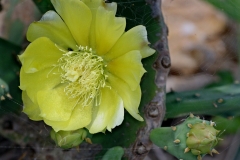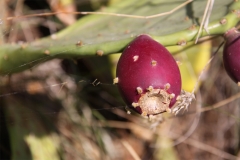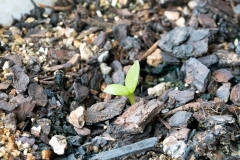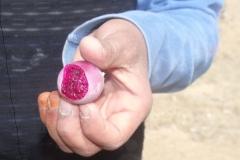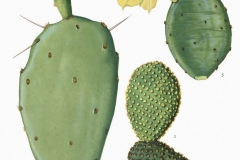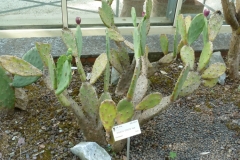| Erect Prickly Pear Quick Facts |
| Name: |
Erect Prickly Pear |
| Scientific Name: |
Opuntia stricta |
| Origin |
Native to the Caribbean region, tropical and subtropical coast of eastern North America, and adjacent South America |
| Colors |
Red to purplish red |
| Shapes |
Ellipsoid or barrel-shaped, 4–6 cm long, 2.5–4 cm diameter
|
| Flesh colors |
Reddish |
Erect Prickly Pear is a spreading to erect and succulent shrub which reaches to the height of 1-2 meters with shallow fibrous roots. Stems are glabrous, dull green or bluish green which consists of flattened, jointed fleshy and obovate segments usually 30 cm long by 15 cm wide by 1–2 cm thick. Aeroles are three to five per diagonal row across mid-stem segment. Aeroles have tufts of short fine and barbed bristles and one to two straight or curve and yellow aging brown and stout spines which is 2-4 cm long. Leaves are small and conical and are shed as the segment matures. Flowers are cyclic, hermaphrodite and actinomorphic which is 6-8 cm across and sessile with fleshy base borne on segment margins having inner tepals lemon yellow. Fruits have red to purplish red skin having depressed cavity in one end and is pear shaped and ellipsoid or barrel shaped about 4–6 cm long and 2.5–4 cm diameter. Flesh is juicy and reddish. Seeds are rounded, pale brown, 4-5 mm in diameter having slightly irregular surface and embedded in pulp.
Stems
Stems are hairless, dull green or bluish-green and consists of series of fleshy segments each 30 cm long, 15 cm wide and 1-2 cm thick. Each areole has short tufts, finely barbed bristles and one to two stout yellow spines which measures 2-4 cm long.
Leaves
Leaves are erect and scale like formed beneath the aeroles on young segments and are shed as segments matures.
Flowers
Flower petals are lemon yellow having greenish or pinkish markings on the back. Flowers are 6-8 cm diameter and are stalkless.
Fruit
Fruits have reddish-purple skin and reddish flesh. Fruit is 4-6 cm long and has tufts of fine barbed bristles in areoles.
Traditional uses
- It is used as antidiabetic and anti-inflammatory in folk medicine.
- Stem segments are used to treat whooping coughs and diabetes.
- The plant is used in India for burning, biliousness, urinary complaints, leucoderma, loss of consciousness, tumors, inflammations, piles, ulcers, anemia and enlargement of spleen.
- Heated plant juice is used for tumors and leucoderma.
- It is used for gonorrhea.
- Apply the mashed leaves as poultice to alleviate heat and inflammation.
- Apply the leaf pulp to eyes in case of ophthalmia.
- Flowers are used for asthma and bronchitis.
- Roots are used to induce vomiting in case of poisonous snake bites.
References:
https://www.itis.gov/servlet/SingleRpt/SingleRpt?search_topic=TSN&search_value=19736#null
https://en.wikipedia.org/wiki/Opuntia_stricta
Comments
comments



